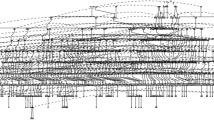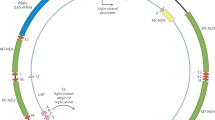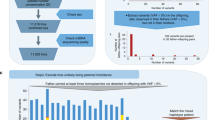Abstract
The analysis of mitochondrial DNA (mtDNA) has been a potent tool in our understanding of human evolution, owing to characteristics such as high copy number, apparent lack of recombination1, high substitution rate2 and maternal mode of inheritance3. However, almost all studies of human evolution based on mtDNA sequencing have been confined to the control region, which constitutes less than 7% of the mitochondrial genome. These studies are complicated by the extreme variation in substitution rate between sites, and the consequence of parallel mutations4 causing difficulties in the estimation of genetic distance and making phylogenetic inferences questionable5. Most comprehensive studies of the human mitochondrial molecule have been carried out through restriction-fragment length polymorphism analysis6, providing data that are ill suited to estimations of mutation rate and therefore the timing of evolutionary events. Here, to improve the information obtained from the mitochondrial molecule for studies of human evolution, we describe the global mtDNA diversity in humans based on analyses of the complete mtDNA sequence of 53 humans of diverse origins. Our mtDNA data, in comparison with those of a parallel study of the Xq13.3 region7 in the same individuals, provide a concurrent view on human evolution with respect to the age of modern humans.
This is a preview of subscription content, access via your institution
Access options
Subscribe to this journal
Receive 51 print issues and online access
$199.00 per year
only $3.90 per issue
Buy this article
- Purchase on Springer Link
- Instant access to full article PDF
Prices may be subject to local taxes which are calculated during checkout




Similar content being viewed by others
References
Olivio, P. D., Van de Walle, M. J., Laipis, P. J. & Hauswirth, W. W. Nucleotide sequence evidence for rapid genotypic shifts in the bovine mitochondrial DNA D-loop. Nature 306, 400– 402 (1983).
Brown, W. M., George, M. Jr & Wilson, A. C. Rapid evolution of animal mitochondrial DNA. Proc. Natl Acad. Sci. USA 76, 1967– 1971 (1979).
Giles, R. E., Blanc, H., Cann, H. M. & Wallace, D. C. Maternal inheritance of human mitochondrial DNA. Proc. Natl Acad. Sci. USA 77, 6715–6719 (1980).
Tamura, K. & Nei, M. Estimation of the number of nucleotide substitutions in the control region of mitochondrial DNA in humans and chimpanzees. Mol. Biol. Evol. 10, 512– 526 (1993).
Maddison, D. R., Ruvolo, M. & Swofford, D. L. Geographic origins of human mitochondrial DNA: phylogenetic evidence from control region sequences. Syst. Biol. 41, 111–124 (1992).
Torroni, A. et al. mtDNA analysis reveals a major late Paleolithic population expansion from southwestern to northeastern Europe. Am. J. Hum. Genet. 62, 1137–1152 ( 1998).
Kaessmann, H., Heissig, F., von Haeseler, A. & Paabo, S. DNA sequence variation in a non-coding region of low recombination on the human X chromosome. Nature Genet. 22, 78 –81 (1999).
Strimmer, K. & von Haesseler, A. Quartet puzzling: a quartet maximum-likelihood method for reconstructing tree topologies. Mol. Biol. Evol. 13, 964–969 (1996).
Sarich, V. M. & Wilson, A. C. Generation time and genomic evolution in primates. Science 179, 1144– 1147 (1973).
Andrews, P. Evolution and environment in the Hominoidea. Nature 360, 641–646 (1992).
Kumar, S. & Hedges, S. B. A molecular timescale for vertebrate evolution. Nature 392, 917– 920 (1998).
Awadalla, P., Eyre-Walker, A. & Smith, J. M. Linkage disequilibrium and recombination in hominid mitochondrial DNA. Science 286, 2524– 2525 (1999).
Eyre-Walker, A., Smith, N. H. & Smith, J. M. How clonal are human mitochondria? Proc. R. Soc. Lond. B 266, 477–483 (1999).
Kumar, S., Hedrick, P. & Stoneking, M. Questioning evidence for recombination in human mitochondrial DNA. Science 288, 1931 ( 2000).
Lewontin, R. C. The interaction of selection and linkage. I. General considerations; heterotic models. Genetics 49, 49– 67 (1964).
Vigilant, L., Stoneking, M., Harpending, H., Hawkes, K. & Wilson, A. C. African populations and the evolution of human mitochondrial DNA. Science 253, 1503–1507 (1991).
Cann, R. L., Stoneking, M. & Wilson, A. C. Mitochondrial DNA and human evolution. Nature 325, 31–36 ( 1987).
Wolpoff, M. H. in The Human Revolution: Behavioural and Biological Perspectives on the Origins of Modern Humans (eds Mellars, P. & Stringer, C.) 62–108 (Princeton Univ. Press, Princeton, New Jersey, 1989).
Horai, S., Hayasaka, K., Kondo, R., Tsugane, K. & Takahata, N. Recent African origin of modern humans revealed by complete sequences of hominoid mitochondrial DNAs. Proc. Natl Acad. Sci. USA 92, 532–536 ( 1995).
Ruvolo, M. et al. Mitochondrial COII sequences and modern human origins. Mol. Biol. Evol. 10, 1115–1135 (1993).
Templeton, A. R. Human origins and analysis of mitochondrial DNA sequences. Science 255, 737 (1992).
Nei, M. Age of the common ancestor of human mitochondrial DNA. Mol. Biol. Evol. 9, 1176–1178 ( 1992).
Saitou, N. & Nei, M. The neighbor-joining method: a new method for reconstructing phylogenetic trees. Mol. Biol. Evol. 4, 406–425 (1987).
Zietkiewicz, E. et al. Genetic structure of the ancestral population of modern humans. J. Mol. Evol. 47, 146– 155 (1998).
Rogers, A. R. & Harpending, H. Population growth makes waves in the distribution of pairwise genetic differences. Mol. Biol. Evol. 9, 552–569 ( 1992).
Fu, Y. X. & Li, W. H. Statistical tests of neutrality of mutations. Genetics 133, 693– 709 (1993).
Tajima, F. Statistical method for testing the neutral mutation hypothesis by DNA polymorphism. Genetics 123, 585–595 (1989).
Rozas, J. & Rozas, R. DnaSP, DNA sequence polymorphism: an interactive program for estimating population genetics parameters from DNA sequence data. Comput. Appl. Biosci. 11, 621–625 (1995).
Klein, R. G. The Human Career: Human Biological and Cultural Origins (Univ. Chicago Press, Chicago, 1989).
Reider, M. J., Taylor, S. L., Tobe, V. O. & Nickerson, D. A. Automating the identification of DNA variations using quality-based fluorescence re-sequencing: analysis of the human mitochondrial genome. Nucleic Acids Res. 26, 967–973 ( 1998).
Acknowledgements
We thank M. Stoneking for his advice regarding the analysis of recombination, and L. Cavalli-Sforza, G. Destro-Bisol, L. Excoffier, T. Jenkins, K. Kidd, J. Kidd, G. Klein, R. Mahabeer, V. Nasidze, E. Poloni, H. Soodyall, M. Stoneking, M. Voevoda and S. Wells for scmples. This work was supported by grants from Swedish Natural Sciences Research Council and Beijer Foundation.
Author information
Authors and Affiliations
Corresponding author
Rights and permissions
About this article
Cite this article
Ingman, M., Kaessmann, H., Pääbo, S. et al. Mitochondrial genome variation and the origin of modern humans. Nature 408, 708–713 (2000). https://doi.org/10.1038/35047064
Received:
Accepted:
Issue Date:
DOI: https://doi.org/10.1038/35047064
This article is cited by
-
Dating ancient splits in phylogenetic trees, with application to the human-Neanderthal split
BMC Genomic Data (2024)
-
Polymorphism of the IL-10 gene in Azeri population of Iran
Egyptian Journal of Medical Human Genetics (2022)
-
Pedigree derived mutation rate across the entire mitochondrial genome of the Norfolk Island population
Scientific Reports (2022)
-
African mitochondrial haplogroup L7: a 100,000-year-old maternal human lineage discovered through reassessment and new sequencing
Scientific Reports (2022)
-
Genomic analysis of a novel Neanderthal from Mezmaiskaya Cave provides insights into the genetic relationships of Middle Palaeolithic populations
Scientific Reports (2022)
Comments
By submitting a comment you agree to abide by our Terms and Community Guidelines. If you find something abusive or that does not comply with our terms or guidelines please flag it as inappropriate.



